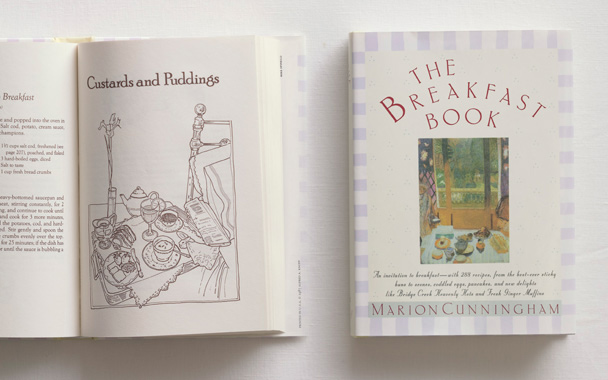When Marion Cunningham’s The Breakfast Book made its debut back in 1987 (Knopf; 288 recipes), there was little, if any, competition. Today, if you Google “breakfast cookbooks,” you’ll find more than a million entries on the subject. So why, given all the current interest, are we still so enamored of this homey classic that we’ve chosen it as this month’s selection? The answer lies not so much with our attraction to the comfort foods of our childhood as with this seasoned cook’s serious attention to the seemingly humblest of meals, not to mention her good old-fashioned know-how. (After all, she edited The Fannie Farmer Cookbook, authored The Fannie Farmer Baking Book, and roamed across the country cooking with James Beard.)
Cunningham’s goal here was far greater than strictly collecting recipes. She wanted to bring the family together at the breakfast table, and she used these pages to coax the home cook into the kitchen every morning to make this possible. The book’s tone is friendly, straightforward, and honest, and the recipes are delicious. When Cunningham says that the Bridge Creek Heavenly Hots are the lightest of hot cakes, you know they are featherlight. Her Raised Waffles, which are made with yeast, have earned decades of acclaim for their crisp exteriors and eggy interiors, and there are many of us (Gourmet editor in chief Ruth Reichl, for one) who constantly make the Great Coffee Cake because it is so moist and rich. In every chapter, there are surefire favorites waiting to be found: quick breads (white corn bread with fresh sage); yeast breads (a raisin-packed cinnamon wheat bread); cereals (honey granola with lots of crunch); eggs (shirred lemon eggs); meat and fish (pork tenderloin with cream biscuits and gravy; kedgeree made with smoked haddock); puddings (steamed persimmon pudding); condiments (rhubarb ginger jam); and even beverages (frothy malted milk).
Interspersed among the recipes are cozy line drawings and quotes from writers, poets, and friends. My favorite tidbit is a list of breakfast-table civility and deportment written by the author herself (especially number four: “Reading the newspaper at the table is permissible, but a pleasant word or salutation must be spoken to all present”; and number seven: “Because everyone is defenseless at breakfast, there should be no contentiousness or crossness”). There are also plenty of indispensable cooking reminders: Baking powder needs to be replaced every few months to ensure effectiveness; bread toasted under the broiler tastes better; loose tea makes a superior cup; and cornflakes not only add crunch to French toast but prevent a soggy bottom piecrust when used to line pastry dough.
Although Marion Cunningham, now an octogenarian, may no longer be writing cookbooks, her legacy is already firmly in place. This visionary cook seems to have worked that out years ago when she wrote here, “Cooking is one of the legacies we can leave to the future, and I would like to be remembered for my baking. We all know we’re not immortal, but after I’m gone, I would like my son and daughter to be able to say, ‘Our mother made real yeast bread for breakfast.’”
New Slang
The pancakes we enjoy today were originally called froise, from the Latin frigere (to fry). The obvious compound of pan and cake was in use in Britain by the early 15th century. The colonists brought synonyms across the Atlantic: flapjacks (to flap was to flip and jack meant “food” in certain British dialects) and hot cakes (popular in the late 17th century), among several others. —Chris Dudley
- Selected recipes: (registration required)
- Bridge Creek Heavenly Hots
- The Coach House Bread and Butter Pudding
- Great Coffee Cake
- Dried Fruit Cream Scones
- Raised Waffles
- Welsh Rabbit with Beer




 Pinterest
Pinterest






